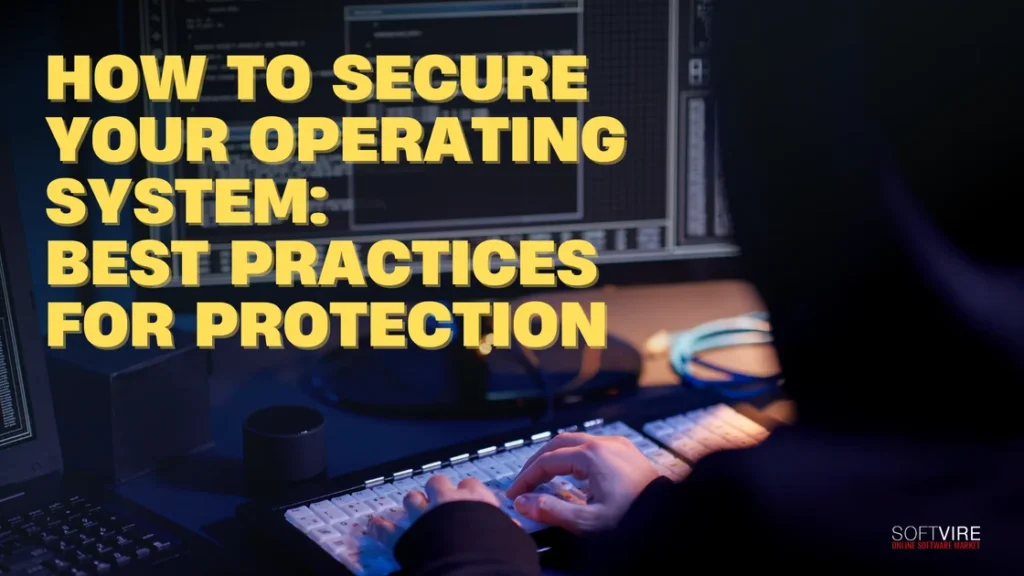The most significant program on any computer—the operating system—is left open to attacks due to a lack of security safeguards. This slows down the machine and compromises important data. The average business owner or C-suite executive may view cybersecurity as frightening despite its popularity in the IT and business worlds.
Since cybersecurity is a broad field, it may be difficult to understand even a small number of complex security procedures or compliance requirements.
In this blog, we will learn how to safeguard your operating system to preserve its availability, functionality, and secrecy while guaranteeing peak performance.
Why Operating System Security Matters
Your computer’s OS is the foundation upon which your whole digital ecosystem rests. Its role as the link between the two will ensure your hardware and software run smoothly.
But it is also in very high demand by hackers. A vulnerable operating system would be more prone to attacks by malware, ransomware, and unwanted access. Potential consequences of a breach include:
- Data Loss: Personal or business-critical data can be stolen or erased.
- Privacy Violation: Sensitive information that is exposed leads to the theft of identities or corporate espionage.
- System Downtime: An infected computer system may freeze or lock up, reducing production.
Investing time securing your OS ensures long-term safety for your data, applications, and overall digital experience.
Best Practices for Securing Your Operating System
Choose a Secure Operating System
There is a huge difference in security between different types of operating systems. Take Windows 11 Pro as an example; its strong security attributes make it a highly recommended choice for home and office work.
With built-in features such as BitLocker and Windows Defender, it is very strong against modern-day threats and offers a strong defense against them. Choose an operating system with a reputation for dependability, robust encryption features, and regular upgrades.
Update your OS regularly.
Operating system security may be as easy as ensuring your OS is always up-to-date with vendor-released patches and updates. Security patches, new features, and bug fixes are standard components of OS upgrades, which also improve the OS’s speed and reliability. Another way to protect yourself against attacks that target outdated operating systems is to keep your OS up-to-date. You can manually check for updates or activate automatic updates in the OS settings.
Third-party software like web browsers, office tools, and media players should also be updated regularly to improve OS security. Keeping these apps up to date fixes any security holes, lowering the hacking risk. You can make your OS even safer and protect your private data even more by turning on two-factor authentication and using strong, unique passwords for each account.
Use strong passwords and encryption.
Strong passwords and encryption for user accounts, files, and folders help protect your operating system further. Strong passwords should blend letters, numbers, and symbols so they are challenging to figure out or break.
It is also advised to periodically change your passwords, as using the same one for many accounts or services is not recommended. Encryption jams your data so only authorized users may access it. You may encrypt specific files and directories or your whole hard disk using built-in or outside programs. Encryption protects your information against theft, loss, or unwanted access.
Adding multi-factor authentication (MFA) to your user accounts makes them safer. MFA makes users show at least two forms of ID before they can access their account. For example, a password and a one-time code sent to a mobile device are two examples of two forms of ID. It makes it much less likely that someone will get in without your permission, even if your password is stolen.
Install and update antivirus software.
Antivirus software is recommended to protect your operating system, data, and applications against malicious software, including viruses, worms, trojans, spyware, and ransomware.
Antivirus software may protect you from security threats by blocking dangerous websites, emails, and downloads. To safeguard your computer, install a trustworthy antivirus program and ensure it is routinely updated with the most recent virus definitions and signatures. Scans should be performed periodically, and any malware found should be removed.
Enable firewall and network security.
The firewall is a feature responsible for monitoring and filtering your computer’s incoming and outgoing network traffic, preventing unauthorized or suspicious connections. It can also safeguard against hackers, malware, and other intruders from accessing your operating system or obtaining your data.
Your operating system’s settings or a third-party firewall program may be used. To beef up your network’s defenses, use a private Wi-Fi network, turn off file sharing and remote access, and stay away from public or unsecured networks.
Limit user privileges and permissions.
Restricting the user rights and permissions that you and other users have on your device is the fourth method of operating system security. What you can do on your operating system, including installing or uninstalling applications, changing settings, and accessing files, depends on your user rights and permissions.
You should utilize a standard user account for your daily tasks and a distinct administrator account to facilitate system maintenance and configuration. You should also limit other users’ or guests’ access and privileges on your device, particularly if you share it with others.
Backup your data and system
Regular data and system backups provide your OS with a fifth layer of protection. If your machine were ever to crash, get corrupted, or be attacked, you could recover your data and settings from a backup.
Recovering your data and operating system from a backup ensures you retain all crucial information and functionality. Various options for backing up your system and data exist, including external devices and cloud services. You must also check your backups regularly to ensure they function correctly.
Apply security updates
Security updates are patches or fixes from the manufacturer of the operating system developer. They update programs’ vulnerabilities, faults, or mistakes of the program to provide increased stability and compatibility and better performance to guard against new and emerging threats.
These ought to be distributed within the shortest possible time for their availability from their developers, and routine checking must be undertaken on availability.
Your operating system might offer automatic updates on availability if this is accessible.
Why Windows 11 Pro Stands Out for Security
Windows 11 Pro is designed to meet modern security challenges. Here’s why it’s a top choice:
- Hardware-Based Security: Features like TPM 2.0 and Secure Boot ensure your device’s security from the moment it powers on.
- Enhanced Encryption: BitLocker protects sensitive data with advanced encryption.
- Seamless Integration: Built-in tools like Microsoft Defender work seamlessly with other Microsoft 365 applications for holistic security.
- Business Features: Group Policy, remote desktop, and enterprise-grade VPN support are ideal for business environments.
Final Thoughts
Maintaining the safety of your operating system involves all these things, requiring a constant update, very stringent authentication, encrypted connection, and constant vigil on a potential threat.
Implementing these best practices ensures your data security, personal and professional, from increasing cyber threats and secures your operating system.
Whether you are an individual user or an administrator of an enterprise, investment in an OS with fantastic security will save you like Windows 11 Pro for business in the long run, saving you time, money, and stress. Take steps today to ensure a safer digital tomorrow.



